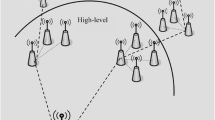Abstract
Given a set of \(n\) sensors, the strong minimum energy topology (SMET) problem in a wireless sensor network is to assign transmit powers to all sensors such that (i) the graph induced only using the bi-directional links is connected, that is, there is a path between every pair of sensors, and (ii) the sum of the transmit powers of all the sensors is minimum. This problem is known to be NP-hard. In this paper, we study a special case of the SMET problem, namely , the \(k\)-strong minimum energy hierarchical topology (\(k\)-SMEHT) problem. Given a set of \(n\) sensors and an integer \(k\), the \(k\)-SMEHT problem is to assign transmission powers to all sensors such that (i) the graph induced using only bi-directional links is connected, (ii) at most \(k\) nodes of the graph induced using only bi-directional links have two or more neighbors, that is they are non-pendant nodes, and (iii) the sum of the transmit powers of all the sensors in \(G\) is minimum. We show that \(k\)-SMEHT problem is NP-hard for arbitrary \(k\). However, we propose a \(\frac{k+1}{2}\)-approximation algorithm for \(k\)-SMEHT problem, when \(k\) is a fixed constant. Finally, we propose a polynomial time algorithm for the \(k\)-SMEHT problem for \(k=2\).


Similar content being viewed by others
References
Akyildiz IF, Su W, Sankarasubramaniam Y, Cayirci E (2002) Wireless sensor networks: a survey. Comput Netw 38(4):393–422
Bandyopadhyay S, Coyle EJ (2003) An energy efficient hierarchical clustering algorithm for wireless sensor networks. Twenty-second annual joint conference of the IEEE computer and communications (INFOCOM 2003), vol. 3, pp. 1713–1723
Belding-Royer EM (2003) Multi-level hierarchies for scalable ad hoc routing. Wirel Netw 9(5):461–478
Bellavista P, Magistretti E (2007) k-hop backbone formation in ad hoc networks. Proceedings of 16th international conference on computer communications and networks (ICCCN 2007), pp. 479–484
Bilò D, Proietti G (2008) On the complexity of minimizing interference in ad-hoc and sensor networks. Theor Comput Sci 402(1):43–55
Calinescu G, Wan PJ (2003) Range assignment for high connectivity in wireless ad hoc networks. Proceedings of ad-hoc, mobile, and wireless networks. LNCS, vol. 2865, Springer, pp. 235–246
Cheng X, Narahari B, Simha R, Cheng MX, Liu D (2003) Strong minimum energy topology in wireless sensor networks: Np-completeness and heuristics. IEEE Trans Mob Comput 2(3):248–256
Chiasserini CF, Chlamtac I, Monti P, Nucci A (2006) Energy efficient design of wireless ad hoc networks. NETWORKING 2002: networking technologies, services, and protocols; performance of computer and communication Networks; mobile and wireless communications. Springer, Berlin, pp 376–386
Du D, Pardalos PPM (1998) Handbook of combinatorial optimization, vol 4. Springer, New York
Estrin D, Govindan R, Heidemann J, Kumar S (1999) Next century challenges: scalable coordination in sensor networks. In: Proceedings of the 5th annual ACM/IEEE international conference on mobile computing and networking, ACM, pp. 263–270
Fernandess Y, Malkhi D (2002) K-clustering in wireless ad hoc networks. In: Proceedings of the second ACM international workshop on principles of mobile computing, ACM, pp. 31–37
Gonzalez TF (2007) Handbook of approximation algorithms and metaheuristics. CRC Press, Boca Raton
Heinzelman WB, Chandrakasan AP, Balakrishnan H (2002) An application-specific protocol architecture for wireless microsensor networks. IEEE Trans Wireless Commun 1(4):660–670
Heinzelman WR, Chandrakasan A, Balakrishnan H (2000) Energy-efficient communication protocol for wireless microsensor networks. Proceedings of the 33rd annual Hawaii IEEE international conference on system sciences
Li D, Du H, Wan PJ, Gao X, Zhang Z, Wu W (2009) Construction of strongly connected dominating sets in asymmetric multihop wireless networks. Theor Comput Sci 410(8):661–669
Mohammed K, Gewali L, Muthukumar V (2005) Generating quality dominating sets for sensor network. In: Sixth IEEE international conference on computational intelligence and multimedia applications, pp. 204–211
Oliveira LB, Wong HC, Loureiro AA, Dahab R (2007) On the design of secure protocols for hierarchical sensor networks. Int J Secure Network 2(3):216–227
Panda BS, Pushparaj Shetty D (2013) Strong minimum energy 2-hop rooted topology for hierarchical wireless sensor networks. J Comb Optim, 1–18. doi:10.1007/s10878-013-9683-z
Pottie GJ, Kaiser WJ (2000) Wireless integrated network sensors. Commun ACM 43(5):51–58
Ramanathan R, Rosales-Hain R (2000) Topology control of multihop wireless networks using transmit power adjustment. In: INFOCOM 2000. Nineteenth annual joint conference of the IEEE computer and communications societies. Proceedings. IEEE, vol. 2, pp. 404–413
Santi P (2005) Topology control in wireless ad hoc and sensor networks. ACM Comput Surv 37(2):164–194
Younis O, Fahmy S (2004) Heed: a hybrid, energy-efficient, distributed clustering approach for ad hoc sensor networks. IEEE Trans Mobile Comput 3(4):366–379
Yu J, Wang N, Wang G (2010) Wireless algorithms, systems, and applications., Heuristic algorithms for constructing connected dominating sets with minimum size and bounded diameter in wireless networksSpringer, Berlin, pp 11–20
Author information
Authors and Affiliations
Corresponding author
Rights and permissions
About this article
Cite this article
Panda, B.S., Shetty, D.P. Strong minimum energy hierarchical topology in wireless sensor networks. J Comb Optim 32, 174–187 (2016). https://doi.org/10.1007/s10878-015-9869-7
Published:
Issue Date:
DOI: https://doi.org/10.1007/s10878-015-9869-7




